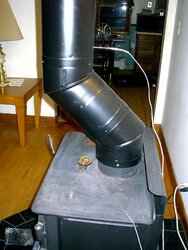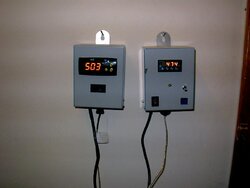I would like to have a better idea/better control on my stove temps. My insert is somewhat flush so I would need some kind of thermometer with a remote sensor, which I could place behind the surround somewhere on the top of the stove. Is anyone aware of a thermometer that would fit the bill for these kinds of temps? Any recommendations?
Looking for Thermometer with Remote Sensor for Insert
- Thread starter op_man1
- Start date
-
Active since 1995, Hearth.com is THE place on the internet for free information and advice about wood stoves, pellet stoves and other energy saving equipment.
We strive to provide opinions, articles, discussions and history related to Hearth Products and in a more general sense, energy issues.
We promote the EFFICIENT, RESPONSIBLE, CLEAN and SAFE use of all fuels, whether renewable or fossil.
You are using an out of date browser. It may not display this or other websites correctly.
You should upgrade or use an alternative browser.
You should upgrade or use an alternative browser.
- Status
- Not open for further replies.
WES999
Minister of Fire
Surprisingly there is nothing commercially available that I am aware of to measure the flue or stove top temps.
So I built my own. I have two on each of my 2 stoves, one for flue temp and another for stove top temp. They have high and low temp alarms built in, to indicate if your stove is too hot or you need to add wood.
They are a great help to let you know when the stove is over-firing in case you forget to turn down the air after re-loading.
PM me if you want more info.
So I built my own. I have two on each of my 2 stoves, one for flue temp and another for stove top temp. They have high and low temp alarms built in, to indicate if your stove is too hot or you need to add wood.
They are a great help to let you know when the stove is over-firing in case you forget to turn down the air after re-loading.
PM me if you want more info.
Attachments
LLigetfa
Minister of Fire
There are lots of industrial thermometer pressure gauges with long capillary tubes for remote sensing but they are neither cheap nor cosmetically suited for most home hearths.
http://www.cnpressuregauge.com/sell-Thermometers.htm
http://www.cnpressuregauge.com/sell-Thermometers.htm
'bert
Minister of Fire
Have you considered an IR heat gun? Works great for stove temps and a lot of other uses too. I can sit in my fav chair and aim it at the glass and know about where the rest of the temps will be. Now in my sixth year of having my BIS I can usually guess the temps within + /- 50 degrees. Close enough for me.
Gooserider
Mod Emeritus
They make industrial controller units that can take various sorts of thermocouples depending on the range of temps required - I've seen mention of several over in the boiler room, one is a Auber Instruments that has a couple of units that look interesting for not all that much money.
Gooserider
Gooserider
Thanks for the responses - given the location of the insert (living room), I want to avoid all types of wires. It needs to pass the wife test! I also don't have a lot of money to spend on this.
From the responses I got, it looks like the IR gun might work, although it isn't cheap (from what I've seen so far). Just wondering, 'Berta Burner, how do you know that there is an approx. 50 degree variance between the IR Gun and your stovetop temps? What is your baseline? And where on the unit do you get your most accurate temps?
With all the wireless technology we have these days, it's surprising that we wouldn't have access to wireless temperature technology for these temp ranges - lower price point would result in great sales, I would think. Probably a business opportunity for someone out there...
From the responses I got, it looks like the IR gun might work, although it isn't cheap (from what I've seen so far). Just wondering, 'Berta Burner, how do you know that there is an approx. 50 degree variance between the IR Gun and your stovetop temps? What is your baseline? And where on the unit do you get your most accurate temps?
With all the wireless technology we have these days, it's surprising that we wouldn't have access to wireless temperature technology for these temp ranges - lower price point would result in great sales, I would think. Probably a business opportunity for someone out there...
'bert
Minister of Fire
I was not saying that there is a 50 degree difference between my temp gun readings and actual temp. I am saying that I can tell from the look and feel of the stove "about what temp it's at" More or less, just tossed out the 50 degree number. In reality I know when it's below 400 and above 600 and then there is that scary little voice that tells me every once in a while that it is well over 800. That is when the temp gun comes out, to see how badly I have messed up. :ahhh:
I guess I am saying that I now have a "feeling" for where the stove temp should be at. I used the heat gun to help me find that feeling.
As far as a temp gun I have a Fluke 561 HVAC Pro. Here is a link:
http://ca.fluke.com/caen/products/Fluke+561.htm?catalog_name=FlukeCanada&category=INFTHE(FlukeProducts)
Be sure to check the temp range of what ever you decide to buy as many of the IR temp guns are not suitable for upper range of where our stove are run at.
I guess I am saying that I now have a "feeling" for where the stove temp should be at. I used the heat gun to help me find that feeling.
As far as a temp gun I have a Fluke 561 HVAC Pro. Here is a link:
http://ca.fluke.com/caen/products/Fluke+561.htm?catalog_name=FlukeCanada&category=INFTHE(FlukeProducts)
Be sure to check the temp range of what ever you decide to buy as many of the IR temp guns are not suitable for upper range of where our stove are run at.
Stevebass4
Minister of Fire
op_man1 said:Thanks for the responses - given the location of the insert (living room), I want to avoid all types of wires. It needs to pass the wife test! I also don't have a lot of money to spend on this.
From the responses I got, it looks like the IR gun might work, although it isn't cheap (from what I've seen so far). Just wondering, 'Berta Burner, how do you know that there is an approx. 50 degree variance between the IR Gun and your stovetop temps? What is your baseline? And where on the unit do you get your most accurate temps?
With all the wireless technology we have these days, it's surprising that we wouldn't have access to wireless temperature technology for these temp ranges - lower price point would result in great sales, I would think. Probably a business opportunity for someone out there...
i think i paid $30.00 for my ir gun at harbor frt
i bought this for BBQ'n maybe they have one with higher temps that can be used with stoves
http://www.smarthome.com/3219/Redi-Chek-ET-73-Remote-Smoker-Thermometer/p.aspx
I've thought about going wireless....
http://www.amazon.com/dp/B000RL2ZGO...e=asn&creative=380341&creativeASIN=B000RL2ZGO
It says the probe reads up to 592F, and has a beep/verbal alarm setpoint. Since its a grill thermo, it has a bunch of preset meat doneness temps, but I read the manual and it said it has a ‘manual mode’ where you just set a temp point for the alarm, doesn’t say if that can be 550 (which is a very well done hamburger). 592F seems a little low, but not hopeless. I suspect any of us could place the probe on a ‘cooler’ part of our stoves if needed.
I suspect that continuous duty would do it in pretty quick, or at least go through a lot of batteries. Alternatively, my wireless indoor/outdoor thermo from the same company runs a couple years on a set of batteries….
http://www.amazon.com/dp/B000RL2ZGO...e=asn&creative=380341&creativeASIN=B000RL2ZGO
It says the probe reads up to 592F, and has a beep/verbal alarm setpoint. Since its a grill thermo, it has a bunch of preset meat doneness temps, but I read the manual and it said it has a ‘manual mode’ where you just set a temp point for the alarm, doesn’t say if that can be 550 (which is a very well done hamburger). 592F seems a little low, but not hopeless. I suspect any of us could place the probe on a ‘cooler’ part of our stoves if needed.
I suspect that continuous duty would do it in pretty quick, or at least go through a lot of batteries. Alternatively, my wireless indoor/outdoor thermo from the same company runs a couple years on a set of batteries….
Gooserider
Mod Emeritus
The problem I've found with most of the low cost cooking and household thermometers is that they don't have a high enough working temperature range. While in theory one might be able to replace the sensor with a different one, there isn't any way to recalibrate so that it would read properly...
Gooserider
Gooserider
smokinj
Minister of Fire
Gooserider said:The problem I've found with most of the low cost cooking and household thermometers is that they don't have a high enough working temperature range. While in theory one might be able to replace the sensor with a different one, there isn't any way to recalibrate so that it would read properly...
Gooserider
you can take the temps from a few feet away and come up with a differnt base line "If you will" record your temps and make your judgement off from that.
- Status
- Not open for further replies.
Similar threads
- Replies
- 10
- Views
- 507
- Replies
- 3
- Views
- 498
- Replies
- 1
- Views
- 314
- Replies
- 0
- Views
- 246



